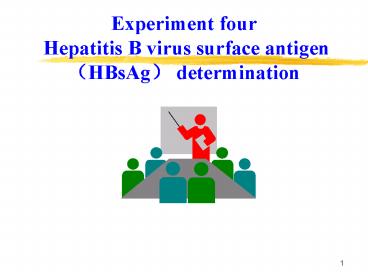Experiment four Hepatitis B virus surface antigenHBsAg determination - PowerPoint PPT Presentation
1 / 22
Title:
Experiment four Hepatitis B virus surface antigenHBsAg determination
Description:
The virus, which is called hepatitis B virus (HBV), can cause ... serum without haemolysis: sample 1?sample 2?sample 3?sample 4. 16. Equipment and supplies ... – PowerPoint PPT presentation
Number of Views:36
Avg rating:3.0/5.0
Title: Experiment four Hepatitis B virus surface antigenHBsAg determination
1
Experiment four Hepatitis B virus surface
antigen(HBsAg) determination
2
What is hepatitis B?
- Hepatitis B is caused by a virus that attacks the
liver. The virus, which is called hepatitis B
virus (HBV), can cause lifelong infection,
cirrhosis of the liver, liver cancer, liver
failure, and death.
3
How is HBV spread?
- Blood transmission (parenteral)
- Perinatal (vertical transmission)
- blood transfusion
4
What are the symptoms of hepatitis B?
- yellow skin or yellowing of the whites of your
eyes (jaundice) - tiredness
- loss of appetite
- nausea
- abdominal discomfort
- dark urine
- joint pain
5
How do you know if you have hepatitis B?
- Only a blood test can tell for sure.
- If viral hepatitis B is suspected clinically,
laboratory evaluation will help confirm the
presence of liver injury, may define the etiology
and may help monitor the course and prognosis of
hepatitis B.
6
What is the HBsAg?
Hepatitis B surface antigen (HBsAg) is a protein
antigen produced by HBV. This antigen is the
earliest indicator of acute hepatitis B and
frequently identifies infected people before
symptoms appear. HBsAg disappears from the blood
during the recovery period.
7
Dane particle
spherical particle
filamentous particle
Photograph of electron microscope
8
Clinical significance
- If HBsAg persistent for more than 6 months, this
situation is referred to as so-called HBsAg
carrier status - The detection of HBsAg therefore either indicates
acute hepatitis B or chronic HBsAg carrier
status. Further investigations are necessary for
differentiation.
9
Detection methods
- Enzyme linked immunosorbent assay (ELISA)
- Chemiluminescent enzyme immunoassay
- Electrochemiluminescent immunoassay
- Radioimmunoassay (RIA)
10
Enzyme linked immunabsorbant assay (ELISA)
Enzyme -gt color
Sample to be tested
HBsAg
Detecting antibody
Capturing antibody
11
Experiment four
- Hepatitis B virus surface antigen(HBsAg)
determination
12
Object
- 1. Master the method and Principle of ELISA for
detecting of hepatitis B surface antigen(HBsAg) - 2.To know the other labeled determination
technique in immunology.
13
Principle(ELISA)
- Sandwich ELISA
14
Reagent
- 1. Microplate coated with monoclonal antibody
specific to HBsAg(Anti-HBs). - 2. Conjugate anti-HBs conjugated to Horseradish
peroxidase - 3. Substrate A hydrogen peroxide
- 4. Substrate B solution of 3,3',5,5' tetramethyl
benzidine (TMB) - 5. Stop Solution
- 6. Wash Buffer (buffer phosphate surfactant)
- 7. Positive Control
- 8. Negative Control
- 9. Plate Sealer
15
Specimen
- serum without haemolysis sample 1?sample
2?sample 3?sample 4
16
Equipment and supplies
- 1. Heating bath 37C
- 2. Microplate washer
- 3. Microplate reader
- 4. Adjustable micropipetter for dispensing 50µL
- 5. tubes 0.5ml?1.5ml
- 6. tubes rack
- 7. micropipetter tips
17
Procedure
- 1. Bring all reagents to room temperature for at
least 30 minutes prior to opening. - 2. Label the Microplate wells with ? -? 1?
2? 3? 4?, Dispense 50µl Positive Control
?negtive control and samples 1-4 into the wells
respectively. - 3. Add 50µl Conjugate into each well, Tap the
plate gently to mix the contents. - 4. Seal the plate with Plate Sealer, Incubate for
30 min at 37??
18
Procedure
- 5. When incubation has been completed, remove the
Plate Sealer, and wash each well five times with
diluted Wash Buffer. (This procedure can be done
by Microplate washer automatically). At the end,
carefully remove remaining fluid by tapping
strips on tissue paper prior to the next step!
19
Procedure
- 6. Add 50µl substrate A and 50µl substrate B to
each well. Tap the plate gently to mix the
contents. Incubate for 10 minutes at room
temperature avoiding sunshine. - 7. Add 50µl Stop Solution into each well, gently
tap the plate. - 8. Measure the absorbance of each well at 450nm.
20
Interpretation of Results
- 1. validityOD value of negative should lt0.1 OD
value of positive should gt0.6 - 2. Calculation of the cut-off
- Cut-off 2.1OD value of negative
- (when the OD value of negativelt0.05, Cut-off
2.10.050.105) - 3. Interpretation of Results
- Samples are considered POSITIVE if the OD
value is higher than or equal to cut-off - Samples are considered NEGATIVE if the OD
value is lower than the cut-off.
21
Caution
- 1. Use fresh pipette tips for each sample,
positive control, negative control and reagent. - 2. To avoid cross-contamination and falsely
positive results, and add controls and samples to
the bottom of the wells without splashing. - 3. All materials should be regarded and handled
as potentially infectious. - 4. Do not use reagents after expiry date
22
Thank you !































